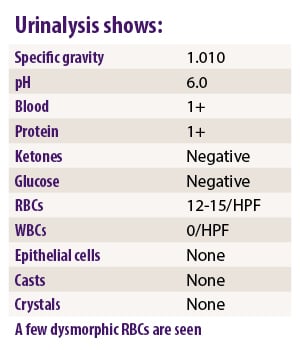If you’re preparing for the United States Medical Licensing Examination (USMLE) Step 2 exam, you might want to know which questions are most often missed by test-prep takers. Check out this example from Kaplan Medical, and read an expert explanation of the answer. Also check out all posts in this series.
This month’s stumper
A 24-year-old man presents to the office for evaluation of hematuria. He was found to have microscopic hematuria during a routine insurance physical examination. The patient says he has been generally healthy until about one year ago, when he started noticing diminished vision and decreased hearing.
He was diagnosed as having anterior lenticonus and sensorineural deafness. The patient has a family history of end-stage renal disease. Two of his maternal uncles have kidney failure and deafness. Physical examination shows blood pressure of 160/100 mm Hg, pulse of 80 per minute, and respiratory rate of 12 per minute. He is afebrile. Skin examination shows no rashes. Lungs are clear to auscultation. CVS examination shows normal S1 and S2 sounds with no rubs or gallops. Abdomen is soft, nontender, and nondistended. Extremities show no pitting edema.
Urinalysis shows:
Which of the following is the most appropriate initial confirmatory test?
A. Audiologic assessment.
B. CT scan of the head.
C. Kidney biopsy.
D. Repeat eye examination.
E. Skin biopsy.
F. Upper gastrointestinal endoscopy.
The correct answer is E.
Kaplan Medical explains why
This patient has Alport syndrome, the diagnosis of which can be made on the basis of an X-linked inheritance of hematuria, sensorineural deafness, and lenticonus. Lenticonus can occur without nephritis and is pathognomonic of the disease. The hematuria progresses to nephritis and may cause renal failure in late adolescence in affected males.
Patients who have Alport syndrome have a defect in the genes encoding the chains responsible for formation of type IV collagen. Most of the patients have a defect in the alpha-5 chain. Others have a defect in alpha-3 or alpha-4 chains.
Why the other answers are wrong
Choices A and D: The patient has established sensorineural hearing loss and anterior lenticonus. Audiologic testing and eye examination only confirm these. They would not be helpful in confirming the diagnosis of Alport syndrome.
Choices B and F: Patients who have Alport syndrome typically have no abnormalities in the brain or gastrointestinal tract. It is unlikely that a CT scan of the head or an upper gastrointestinal endoscopy would be helpful.
Choice C: A kidney biopsy is done only if the results of the skin biopsy are equivocal.
Tips to remember
- Alport syndrome is an X-linked disorder of hematuria, sensorineural deafness, and lenticonus.
- The cause is a defect in type IV collagen.
- Skin biopsy is diagnostic.
The AMA and Kaplan have teamed up to support you in reaching your goal of passing the USMLE® or COMLEX-USA®. If you're looking for additional resources, Kaplan provides free access to tools for pre-clinical studies, including Kaplan’s Lecture Notes series, Integrated Vignettes, Shelf Prep and more.
For more prep questions on USMLE Steps 1, 2 and 3, view other posts in this series.




